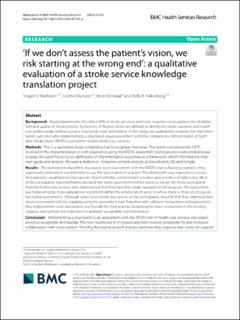| dc.contributor.author | Mathisen, Torgeir Solberg | |
| dc.contributor.author | Eilertsen, Grethe | |
| dc.contributor.author | Ormstad, Heidi | |
| dc.contributor.author | Falkenberg, Helle Kristine | |
| dc.date.accessioned | 2022-03-21T13:39:05Z | |
| dc.date.available | 2022-03-21T13:39:05Z | |
| dc.date.created | 2022-03-18T09:39:55Z | |
| dc.date.issued | 2022 | |
| dc.identifier.citation | Mathisen, T. S., Eilertsen, G., Ormstad, H. & Falkenberg, H. K. (2022). ‘If we don’t assess the patient’s vision, we risk starting at the wrong end’: a qualitative evaluation of a stroke service knowledge translation project. BMC Health Services Research, 22, Artikkel 351. | en_US |
| dc.identifier.issn | 1472-6963 | |
| dc.identifier.uri | https://hdl.handle.net/11250/2986550 | |
| dc.description.abstract | Background: Visual impairments (VIs) affect 60% of stroke survivors and have negative consequences for rehabilitation and quality of life poststroke. Symptoms of VIs post stroke are difficult to identify for stroke survivors and health care professionals without using a structured vision assessment. In this study, we qualitatively evaluate the implementation outcomes after implementing a structured visual assessment with the Competence, Rehabilitation of Sight after Stroke Vision (KROSS) assessment tool in stroke care services.
Methods: This is a qualitative study comprising four focus group interviews. The health care personnel (HCP) involved in the implementation or with experience using the KROSS assessment tool in practice were invited to participate. We used Proctor et al.’s definitions of implementation outcomes as a framework, which informed the interview guide and analysis. We used a deductive - inductive content analysis, as described by Elo and Kyngäs.
Results: The participants found the structured vision assessment with the KROSS tool as being acceptable; they expressed a motivation and intention to use the new routine in practice. They believed it was important to assess their patient’s visual function because it influenced other rehabilitation activities and activities of daily living. Most of the participants reported having adopted the vision assessment in their practice, except for those participants from the home care services who experienced that they have few stroke survivors to follow up on. The assessment was believed to be more appropriate to perform within the rehabilitation services where there is more of a focus on functional assessments. Although vision assessment was new to all the participants, they felt that they improved their vision assessment skills by regularly using the assessment tool. Together with sufficient instructions and supervision, they believed that vison assessment was feasible for their practise. Including the vison assessment in the existing routines and systems was important to promote sustainable implementation.
Conclusion: Implementing a structured vision assessment with the KROSS tool in health care services was experienced as acceptable and feasible. The new routine led to increased attention towards poststroke VIs and increased collaboration with vision experts. Tailoring the routine to each practice and how they organise their work can support the integration of a vision assessment in their routines. To promote better vision care poststroke vision assessment and follow up should be included in the stroke care pathways. | en_US |
| dc.language.iso | eng | en_US |
| dc.rights | Navngivelse 4.0 Internasjonal | * |
| dc.rights.uri | http://creativecommons.org/licenses/by/4.0/deed.no | * |
| dc.title | ‘If we don’t assess the patient’s vision, we risk starting at the wrong end’: a qualitative evaluation of a stroke service knowledge translation project | en_US |
| dc.type | Journal article | en_US |
| dc.type | Peer reviewed | en_US |
| dc.description.version | publishedVersion | en_US |
| dc.rights.holder | © The Author(s) 2022. | en_US |
| dc.source.pagenumber | 351 | en_US |
| dc.source.volume | 22 | en_US |
| dc.source.journal | BMC Health Services Research | en_US |
| dc.identifier.doi | https://doi.org/10.1186/s12913-022-07732-w | |
| dc.identifier.cristin | 2010733 | |
| cristin.ispublished | true | |
| cristin.fulltext | original | |
| cristin.qualitycode | 2 | |

